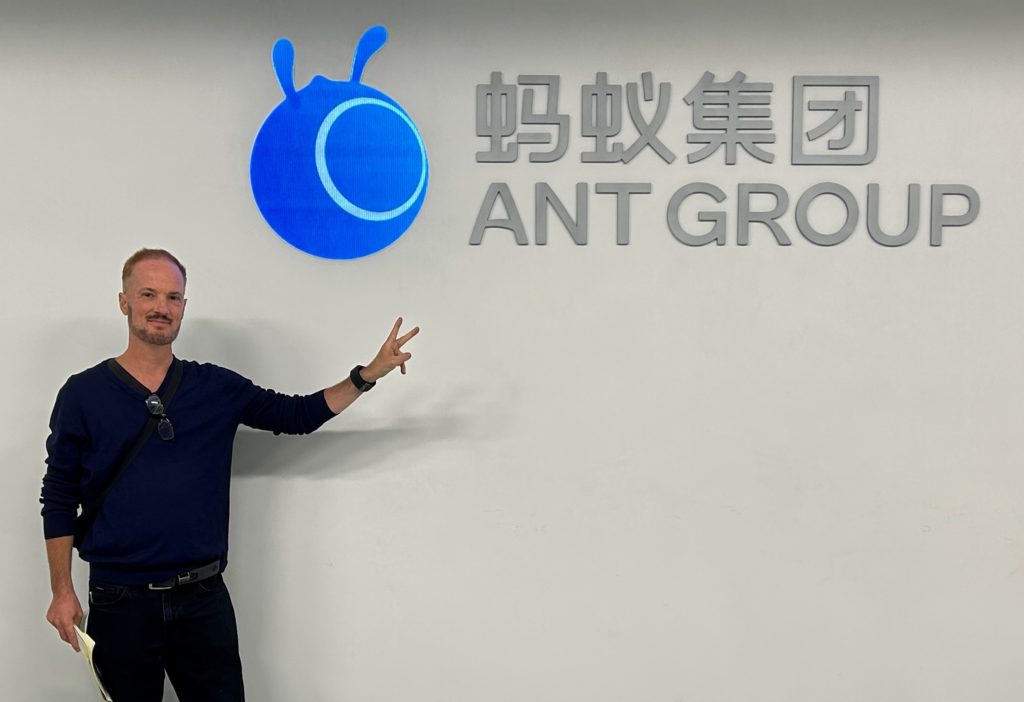I recently visited the Ant headquarters in Hangzhou. This was part of our China Tech Tour. I have already done quick summaries of our visits to ByteDance, Cainiao and Baidu. Which were awesome.
But it was really Ant that left me with the biggest impression from the trip. I had really underestimated the scope of what the company was doing. If there is one China / Asia tech company that people need to pay more attention to, it’s Ant.
China Tech Tour Day 4: Hangzhou and Ant
Our tour group was staying on the West Lake in Hangzhou. The lake front area is really the main tourist attraction for Hangzhou, an old historic capital of China. Pretty much everyone who comes to Hangzhou mostly hangs out and walks around the lake. In the past ten years, it’s gotten a lot fancier with lots of luxury shops and restaurants. I kind of miss the more local Hangzhou of 15 years ago. But it’s basically just a nice, pleasant place to relax, with the lake sandwiched between the town and a ring of mountains. And Hangzhou is hosting the upcoming Asian Games which should be great. Note: Ant Group/Alipay is an official partner. 
Photo by Stewart Edward on Unsplash
And if you drive West around the lake and to the other side of the mountains, you start to see lots of really big tech companies. There is Alibaba’s main campus, which is huge and is currently being redone (i.e., upgraded). There is gaming giant NetEase. There is Cainiao. And there is Ant Group. Arriving around 9am (after a quick coffee run), my first impression was that Ant has a fantastic campus. In fact, all the Alibaba-related companies (Cainiao, Alibaba, Ant) have really spectacular campuses. I’m assuming one architecture firm is responsible for this but have been able to figure out who it is. The campus is backed up against the Hangzhou hills, and they’ve integrated the greenery into the campus. It’s like a combination of an office complex and a park. They’ve even turned part of the campus into a tea farm. 
We started with a tour of their little museum. The highlight of that was a record of the first transaction with Alipay. If you’re curious who was the first customer to ever use Alipay, here he is.
 And then did their exhibition hall, which is the best one I have ever seen. It was like a top tier museum in London or New York. Lots of different rooms, exhibits, videos, etc. We then sat down with some staff from Alipay+ and the digital technologies group. I’ll write more about both of these in the next articles. Overall, a fantastic visit. Here are my three strategy lessons. A disclaimer: None of this is information or opinions from Ant. The discussions are still off the record at this point (but not some of the photos). So, these are my own personal lessons. This is not anything anyone said during the visit.
And then did their exhibition hall, which is the best one I have ever seen. It was like a top tier museum in London or New York. Lots of different rooms, exhibits, videos, etc. We then sat down with some staff from Alipay+ and the digital technologies group. I’ll write more about both of these in the next articles. Overall, a fantastic visit. Here are my three strategy lessons. A disclaimer: None of this is information or opinions from Ant. The discussions are still off the record at this point (but not some of the photos). So, these are my own personal lessons. This is not anything anyone said during the visit.
Lesson 1: mPaaS Was the Key Strategic Move for Ant
One of Ant’s key digital services is mPaaS, which stands for mobile-platform-as-a-service. They describe it as a cloud-to-end, one stop solution for app development, testing, and operation. It’s a cloud based mobile app development platform. It lets companies research, test, release and operate (using their cloud service) their own mobile apps. And it is arguably #1 for this in China, with a client list that is a who’s who of China. Why is this important? Launching this service was a key step in the development of the company and its move into products and services outside of payment. Ant began as Alipay, based on Taobao and Tmall. The company actually describes the early days as riding the two different waves of development. One for digital payment and one for digital connectivity (Note the below graphic). That is actually a pretty great summary of what Ant has been doing. I like how they separate this into payment and connectivity, which is an important distinction.  mPaaS came out of the internal capabilities they had built for Alipay. They began offering their internal development platform as a service and lots of Chinese companies started to use it to develop their own mobile apps. That would turn out to be a key step. mPaaS also helped international banks and e-wallets begin to offer their own payment services, similar to Alipay. That also turned out to be a key step for going international and launching Alipay+ (their major globalization initiative today). Ant has since expanded into a growing suite of digital services. They have moved into technology services for collaboration, finance, security / trust and many other areas. Unsurprisingly, they have a lot of focus on the unique tech requirements for banking and finance. Today, the digital technologies group has tens of products offered with +300 partners and +10,000 clients. I’ll write more about this business unit and its key products (Zoloz, Morse, MaaS) in a subsequent article. But lesson 1 was that Ant is far more involved in the ongoing digitization of Chinese industries than I had appreciated. It looks a lot like a combination of a payment service, a digital finance marketplace and a cloud / tech provider like AWS.
mPaaS came out of the internal capabilities they had built for Alipay. They began offering their internal development platform as a service and lots of Chinese companies started to use it to develop their own mobile apps. That would turn out to be a key step. mPaaS also helped international banks and e-wallets begin to offer their own payment services, similar to Alipay. That also turned out to be a key step for going international and launching Alipay+ (their major globalization initiative today). Ant has since expanded into a growing suite of digital services. They have moved into technology services for collaboration, finance, security / trust and many other areas. Unsurprisingly, they have a lot of focus on the unique tech requirements for banking and finance. Today, the digital technologies group has tens of products offered with +300 partners and +10,000 clients. I’ll write more about this business unit and its key products (Zoloz, Morse, MaaS) in a subsequent article. But lesson 1 was that Ant is far more involved in the ongoing digitization of Chinese industries than I had appreciated. It looks a lot like a combination of a payment service, a digital finance marketplace and a cloud / tech provider like AWS.
Lesson 2: Ant is a Player in Breakthrough Technologies
This was another area I underestimated, and it follows from Lesson 1. I had primarily seen Ant as a payment platform plus a digital finance marketplace. I wrote about this a lot before their planned IPO.
But, as mentioned, I had underestimated how much they were focused on the digitization of industry, especially finance. Hence their big suite of digital technologies services. And their role in collaboration and development platforms. But this also includes their investments in breakthrough technologies. Like Google and AWS, they are a major player in developing the next foundational technologies. And these, obviously, will be used in their own technology services to the clients (currently mostly in China). Ant describes 5 technologies as their main focus.
- Blockchain. This makes sense given their focus on banking, payment and digital finance. They have a huge number of patents for blockchain. And they have some interesting products like TopNode, the #1 NFT platform for China. They also operate a digital content copyright service.
- IoT. They are combining IoT and Blockchain into “AntChain”. This is being positioned as a trusted chain for businesses and devices.
- AI. Not a surprise this is a focus.
- Cloud native. Also, not a surprise. mPaaS is their largest product for cloud services but only one of many.
- Privacy computing. I thought this was an interesting focus. The focus on creating trust and security makes sense given the focus on banking. But I’m not sure how privacy fits into this all yet.
Lesson #2 was that Ant is much closer to Google Cloud, AWS and Alibaba Cloud than I had appreciated. But with more of a finance focus. If Ant goes public in the next year, it will be interesting to see how much this company is viewed as a cloud services company vs. a payment service.
Lesson 3: Alipay+ is the Key to Internationalization.
I’ve written about Alipay+ before. It’s their major internationalization effort.
But it was the first two lessons that really helped me understand it. mPaaS enabled other Chinese companies to build their own apps. But Alipay+ Payment Tech, including mPaaS and other technologies, also enabled international companies to build their own versions of Alipay. Especially banks and mobile wallet providers. Think True in Thailand, easypaisa in Pakistan and GCash in the Philippines. About 20-30 international companies worked with Ant early on and used payment technology to build their own digital wallets and payment systems. They built their payment networks, security systems, and so on by copying Alipay in China (which is smart). These international digital wallet and payment partners would later become the core of Alipay+. How? Basically, by helping these international partners do for their customers what Alipay does for Chinese customers. Alipay has long served Chinese consumers traveling internationally. A Chinese consumer in Paris can pay using their Alipay accounts back home. Alipay makes it really easy. And it gives them good exchange rates. And it was trusted with good security. Alipay has expanding its international services as hundreds of millions of Chinese consumers have been traveling the world. And one of its best services is special marketing deals and promotions for the countries they are traveling in. A Chinese consumer arriving in Paris can get a list of special deals for them in the city. Maybe discounted tickets to Disneyland Paris? Maybe there is a promotion at certain restaurants? It turns out Alipay can get you really good deals when it is negotiating on behalf of a billion consumers. But wouldn’t it be great if Alipay’s digital wallet partners could offer the same types of services for their consumers when they are traveling abroad? That’s Alipay+. It enables digital wallets around the world to provide such payment and marketing services by plugging into Alipay+. Suddenly Korean consumers can pay for things in Singapore using their Kakao wallets from South Korea. And they got a good exchange rate. And it was secure and trusted. And they could partner with Alipay+ to get their customers great deals and promotions as they travel internationally. When Korean consumers arrive in Paris, they might get the same special promotion to visit Disneyland Europe that Alipay had negotiated with Disney on behalf of Chinese consumers. That last point is why Alipay+ is so compelling as a strategy. It can grow internationally based on providing cross-border payment functionality to digital wallets and merchants around the world. That’s a great service. But it also has a big growth path in revenue by also doing cross-border marketing and promotions (which can be monetized). That is really interesting. It could be an almost entirely unique service. And it could have almost unmatched global purchasing power in terms of getting special deals and promotions. Today Alipay+ already integrates over 20 digital payment methods. It serves 1.4B consumers in Asia alone. And it is connected to tens of millions of merchants globally Watch for Alipay+ to rapidly evolve its global marketing services for digital wallets and merchants. This should be really interesting.
***
I’m going to write more about Alipay+ and the technology services business. Those are the areas I think are the most interesting. And they are really off the radar of most investors and CEOs.
Cheers, Jeff
———-
